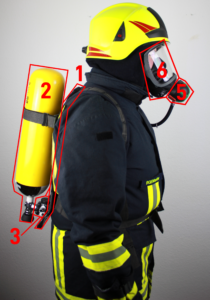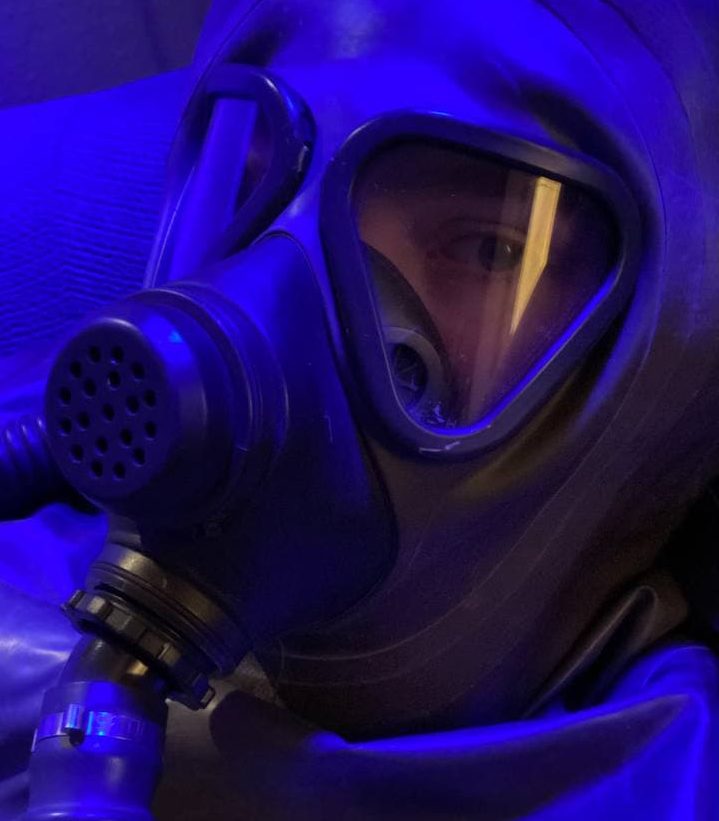SCBAs are fascinating more and more gearheads and kinksters. But there are a few things to keep in mind when handling them. First of all, you should think about a few basic things before you buy such a device. Among other things, this includes the possibility of getting the air tank filled.
Before buying, it is important to read the offer carefully and look at the pictures more closely. Is the test certificate of the bottle still valid? Is the bottle heavily worn? Is the valve bent? Does it have dents or deformations? Does the device show signs of damage, soiling or heavy wear?
Checklist:
- Do I have a possibility to have the bottles filled?
- Is the test certificate of the bottle still valid? Is there a little pressure left in the Tank?
- Does device or Tank show signs of damage, soiling or heavy wear?
- Does the regulator fit on my mask? Learn more about mask connections here

But first a little explanation and introduction to the subject. In order to be able to breathe the air that is compressed with 200 or 300 bar in the cylinder, you need the self-contained breathing apparatus or SCBA.
A SCBA consists of the following parts: 
- the carrying plate which is carried on the back and on which everything is mounted
- the compressed air tank made of steel (usual are 6 liters with 300 bar or 4 liters with 200 bar) or CFK (6,8 liters with 300 bar)
- the pressure reducer that reduces the 300/200 bar high pressure to 4.5-12 bar medium pressure
- the pressure gauge for reading the tank pressure
- the regulator with the connection to the mask
- the respirator mask
Once you have bought a SCBA, filled the cylinder and selected the right regulator for the mask, the exciting part begins: putting it on and breathing with the SCBA.
First, the bottle has to be connected to the device. To do this, I recommend that you place the bottle with the valve facing upwards and then open the bottle strap of the SCBA. Now screw the bottle onto the pressure reducer. This takes a little practice and is a little tricky the first time. Once the bottle is connected, close the buckle on the bottle strap so that the bottle is in the (middle) trough. Now, if you haven't already done so, connect the regulator to the medium pressure line, as this is quite difficult later on under pressure. Finally, screw on the cylinder. If you have connected a positive pressure regulator, make sure that it is locked. You do this by pressing the red button until you feel and hear a click. To open the cylinder, turn the handwheel of the valve counterclockwise until it stops and then turn it back half a turn. When you do this, the residual pressure warning device, colloquially known as the whistle, sounds briefly. It becomes noticeable at a pressure of 50-60 bar or less. You turn the valve back because the air flow and the decompression of the air can cause the valve to cool down considerably and the valve could possibly seize up. Now you are ready to shoulder the device.
To do this, take the carrying plate on a shoulder strap and put the device on your back like a backpack. For the first few times, a second person is recommended to help you. Above all, it is important not to bump the downward pointing valve anywhere. The valve, or the neck of the bottle is the weak point of the compressed air cylinder. Now that the SCBA is on your back, tighten the shoulder straps. Then close the lap belt and tighten it as well.
Now you can choose between two carrying modes: Back-loaded or pelvic-loaded. For the back-loaded carrying method, we leave the straps as they are; for the pelvic-loaded carrying method, we loosen the shoulder straps a little so that the weight of the device rests on the pelvis and no longer on the shoulders. The important thing here is that the straps still remain tight enough that the SCBA doesn't slip off our shoulders. Then there is a combination of both carrying methods, which I personally find best. You loosen the shoulder straps a little bit so that the weight is distributed over the shoulders and pelvis.
Now that we have the carrying plate with the bottle on our backs, it's time to put on the mask and connect the regulator to the mask. If you have a positive pressure regulator, the first time you inhale you will have a small resistance, which ends with a click and the sudden start of the airflow. Now you are completely isolated from the outside world with your breathing air.
If you have been using the bottle for a while, the pressure gauge will eventually drop below 50-60 bar. At this pressure, a whistle will start to blow, signaling that there is little remaining pressure in the cylinder. The compressed air cylinders should never be completely emptied, as this can lead to corrosion.
Finally, a little warning:
Compressed air cylinders are under high pressure. They must therefore be handled with particular care. In addition, compressed air cylinders must never be emptied completely.
Many thanks also to Jan aka jhgd1498, who helped me with the research and gathering of the info.





